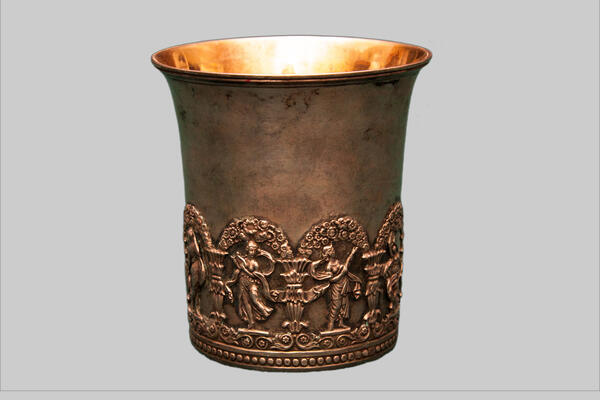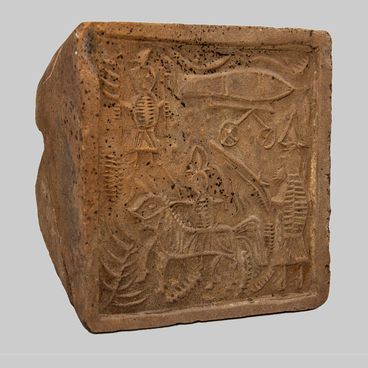The collection of the Tobolsk Museum Reserve contains a collection of silver tableware, which is of great interest to researchers. A glass takes a special place in the collection — it was made by an unknown author in the first half of the 19th century.
Female figures with musical instruments are minted on a silver background as a reminder of the ancient muses — characters of ancient Greek myths. According to the myths, each muse has its own attribute and symbolic item. They live on Mount Parnassus, at the foot of which the Castalian spring flowed, or on mount Helicon with the Hippocrene spring at the foot. Each illustration is a separate miniature painting on metal.
Russian craftsmen created real works of art, we can easily distinguish them by the characteristic artistic style and assay marks acquired over the years. It is known that in Russia, silver tableware became especially popular under Peter I. In 1711, the first silver set was made by his order. At the beginning of the 18th century, many talented craftsmen appeared, and new ways of creating silver products were invented. Products of this period were decorated with scania – openworks made of specially processed wire, covered with enamel.
Later, Catherine II issued a decree that silver table sets and tableware were made of the highest quality silver. This period was characterized by a lack of imitation, as well as an original combination of different styles. Craftsmen of Moscow, Saint Petersburg, cities of the Russian North, and, first of all, Veliky Ustyug, created items of rare beauty and grace. The works created in the ‘New Russian style’ with the use of national ornaments and stylistics were distinguished by their elegance and festivity. The items of the most famous jewelry companies brought Russia fame on international markets.
Under Paul I, repressions for craftsmen-jewelers became tougher – a craftsman with sticky fingers could easily be exiled to hard labor.
Starting from the 19th century, silverware has gained the value of a family heirloom - it was considered an indicator of the status and taste of its owner. Currently, silver tableware, crafted by the talented silversmiths, decorate private collections and museums.
Female figures with musical instruments are minted on a silver background as a reminder of the ancient muses — characters of ancient Greek myths. According to the myths, each muse has its own attribute and symbolic item. They live on Mount Parnassus, at the foot of which the Castalian spring flowed, or on mount Helicon with the Hippocrene spring at the foot. Each illustration is a separate miniature painting on metal.
Russian craftsmen created real works of art, we can easily distinguish them by the characteristic artistic style and assay marks acquired over the years. It is known that in Russia, silver tableware became especially popular under Peter I. In 1711, the first silver set was made by his order. At the beginning of the 18th century, many talented craftsmen appeared, and new ways of creating silver products were invented. Products of this period were decorated with scania – openworks made of specially processed wire, covered with enamel.
Later, Catherine II issued a decree that silver table sets and tableware were made of the highest quality silver. This period was characterized by a lack of imitation, as well as an original combination of different styles. Craftsmen of Moscow, Saint Petersburg, cities of the Russian North, and, first of all, Veliky Ustyug, created items of rare beauty and grace. The works created in the ‘New Russian style’ with the use of national ornaments and stylistics were distinguished by their elegance and festivity. The items of the most famous jewelry companies brought Russia fame on international markets.
Under Paul I, repressions for craftsmen-jewelers became tougher – a craftsman with sticky fingers could easily be exiled to hard labor.
Starting from the 19th century, silverware has gained the value of a family heirloom - it was considered an indicator of the status and taste of its owner. Currently, silver tableware, crafted by the talented silversmiths, decorate private collections and museums.



